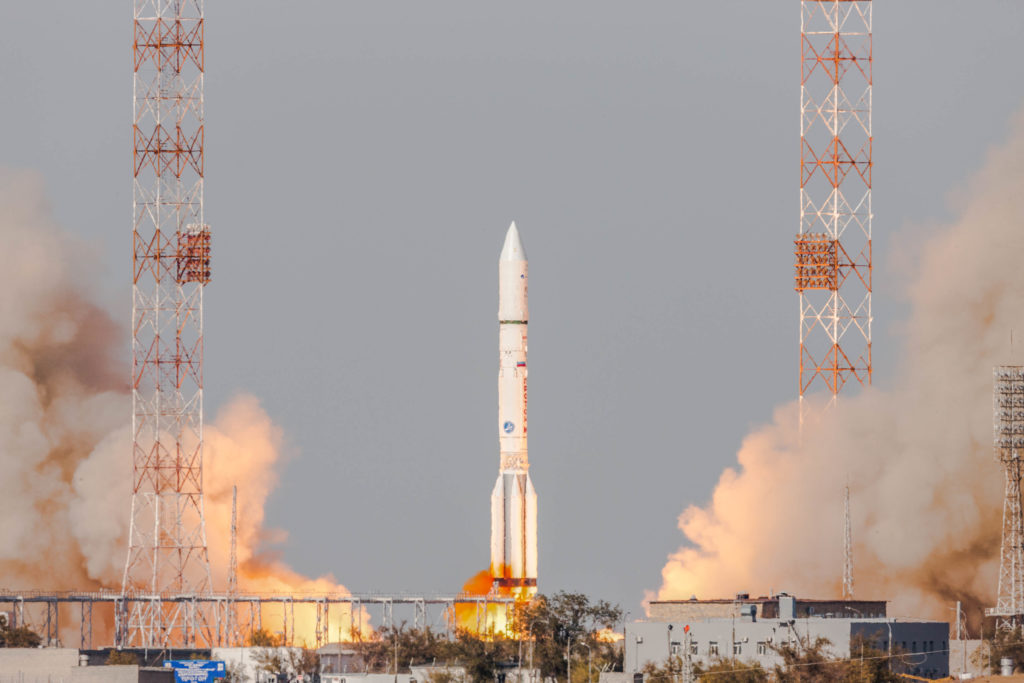The era of commercial satellite servicing is upon us.
The robotic Mission Extension Vehicle-1 (MEV-1) launched atop a Russian Proton rocket today (Oct. 9) from Baikonur Cosmodrome in Kazakhstan at 6:17 a.m. EDT (1017 GMT, 4:17 p.m. local Kazakhstan time).
MEV-1, which was built by Virginia-based company Northrop Grumman, launched along with the Eutelsat 5 West B communications satellite. If all goes according to plan, both spacecraft will deploy into a supersynchronous transfer orbit about 16 hours after liftoff.
Related: On-Orbit Satellite Servicing: The Next Big Thing in Space?
MEV-1 will then make its way to geostationary orbit and eventually link up with the Intelsat 901 communications satellite, which has been circling Earth since June 2001 and is low on fuel. Using its onboard electric thrusters, MEV-1 will take control of the pointing and orbit-maintenance duties for Intelsat 901 — something no other commercial satellite has ever done.
The servicing craft will extend the older spacecraft's life by five years. After that, MEV-1 could theoretically depart and help out another aging satellite.

"The MEV provides a 15-year design life and sufficient fuel to enable well in excess of 15 years of station-kept life while docked with a typical 2,000-kg [4,400 lbs.] geosynchronous satellite," Northrop Grumman representatives wrote in the MEV fact sheet. "The rendezvous, proximity and docking systems of the MEV allow for numerous dockings and undockings during the life of the MEV."
Get the Space.com Newsletter
Breaking space news, the latest updates on rocket launches, skywatching events and more!
ASCENT UNIT COMPLETED: The #EUTELSAT5WestB and #MissionExtensionVehicle1 #spacecraft are now encapsulated in the Payload Fairing (PLF) to form the Ascent Unit (AU). The AU consists of the Integrated Payload System, Adapter System, Breeze M, and PLF. @Eutelsat_SA @northropgrumman pic.twitter.com/ATcGCcBDkJSeptember 23, 2019
Northrop Grumman isn't alone in its satellite-servicing ambitions; many other groups see great potential in this nascent field as well. For example, California-based company Made In Space is developing a spacecraft called Archinaut, which will be able to maintain and upgrade existing satellites and also build huge new structures in orbit.
NASA has carried out several robotic-refueling demonstrations aboard the International Space Station, and the space agency soon plans to launch a mission called Restore-L that will top up the tank of a free-flying government satellite.
The U.S. Defense Advanced Research Projects Agency (DARPA) is also interested in such technology. DARPA launched two prototype servicing satellites in 2007 via a program called Orbital Express and is now developing a new project called Robotic Servicing of Geosynchronous Satellites, though this program has suffered some setbacks recently.
MEV-1's launch companion, 5 West B, will be operated by France-based company Eutelsat. The new communications satellite will replace the 17-year-old 5 West A spacecraft and is expected to operate for at least 15 years.
"This new digital resource will primarily address broadcast markets in France, Italy and Algeria," Eutelsat representatives said in a statement.
- Orbital ATK Unveils New Version of Satellite-Servicing Vehicle
- Orbit Fab Demonstrates Satellite Refueling Technology on Space Station
- Satellite Quiz: How Well Do You Know What's Orbiting Earth?
Mike Wall's book about the search for alien life, "Out There" (Grand Central Publishing, 2018; illustrated by Karl Tate), is out now. Follow him on Twitter @michaeldwall. Follow us on Twitter @Spacedotcom or Facebook.

Join our Space Forums to keep talking space on the latest missions, night sky and more! And if you have a news tip, correction or comment, let us know at: community@space.com.

Michael Wall is a Senior Space Writer with Space.com and joined the team in 2010. He primarily covers exoplanets, spaceflight and military space, but has been known to dabble in the space art beat. His book about the search for alien life, "Out There," was published on Nov. 13, 2018. Before becoming a science writer, Michael worked as a herpetologist and wildlife biologist. He has a Ph.D. in evolutionary biology from the University of Sydney, Australia, a bachelor's degree from the University of Arizona, and a graduate certificate in science writing from the University of California, Santa Cruz. To find out what his latest project is, you can follow Michael on Twitter.









